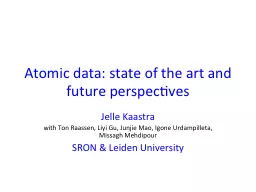

Jelle Kaastra with Ton Raassen Liyi Gu Junjie Mao Igone Urdampilleta Missagh Mehdipour SRON amp Leiden University Introduction Xray emitting plasmas everywhere ID: 813427
Download The PPT/PDF document "Atomic data: state of the art and future..." is the property of its rightful owner. Permission is granted to download and print the materials on this web site for personal, non-commercial use only, and to display it on your personal computer provided you do not modify the materials and that you retain all copyright notices contained in the materials. By downloading content from our website, you accept the terms of this agreement.
Slide1
Atomic data: state of the art and future perspectives
Jelle Kaastra
with
Ton
Raassen
,
Liyi
Gu
,
Junjie
Mao,
Igone
Urdampilleta
,
Missagh
Mehdipour
SRON & Leiden University
Slide2Introduction
X-ray emitting plasmas everywhere:
Solar system to cosmic web filamentsBroad range environments & physical conditions:collisional ionised, photo-ionised, transiently ionisedHigh resolution X-ray spectroscopy key to understand these sourcesNext year launch ASTRO-H with SXS calorimeterOld models not always most up to date atomic physicsNeed tool to model these different sources with same, consistent set atomic parameters
2
Slide3Spectroscopic codes @ SRON
Short history:
1972
Mewe1975 Mewe-Gronenschild1985 Mewe-Gronenschild- Van den Oord
1990
Meka
1994 Mekal1992 SPEX1992 Version 12001 Version 22015 Version 3 (expected release December)Evolution from plasma model to full astrophysical model including data analysis (fitting), plotting & diagnostic output
Slide4Need for updates
Example:
Mewe code (still core present SPEX models) approximates radiative recombination contribution to lines by local power-lawOkay for CIE but:Large deviations for recombining / ionising plasma
T
max
log T
l
og rate
4
Slide5Requirements for updates
Code must allow options for fast calculation yet accurate enough
Minimise number of mathematical operations & data storage for the cross sections/rates follow original strategy of Mewe: simple, accurate & fast approximations, but more accurate & complete than beforeRestrict to Z ≤ 30 (astrophysically most relevant)5
Slide6Updates to atomic data
For full model, need updates of many processes:
Collisional & photo-
ionisation cross sectionsTransition probabilitiesAuto-ionisation ratesRecombination ratesLine energiesEtc.6
Slide7Comparison of codes
(with
Junjie
Mao)7
Wavelength (
Å
)Wavelength (Å)SPEX V 3.0βATOMDB V3.0.2
Log T (K)
Fe
O
Slide8Collisional
ionisation
(with
Igone Urdampilleta)8
Slide9Motivation
In the past, several compilations
Recent one:
Dere 2007Almost always give total ionisation ratesSubshells needed for inner-shell line emissionNew data published since 2007 Revisit collisional ionisation rates9
Slide10Collisional
ionisation
for atoms and ions of H to Zn
Direct ionization cross section fitting procedure:
Relativistic correction (Quarles 1976 and
Tinschert
et al. 1989):Excitation Autoionization fit (Mewe 1972):
where,
Ee
electron
energy
I
ionisation
potential
A, B, D, E fit parameters
C Bethe constant
R relativistic correction
Slide11Examples of fits to collisional
ionisation
cross sections
11QI2 (10-24 m2keV2)
1s
2s
Note Dimensionless scaling
Slide1212
QI
2
(10-24 m2keV2)Relativistic correction
Note dimensionless scaling I ~ Z2 for 1s shell H-sequence
Slide13-
Cl
-
Ar
-K
-
Ca
-
Sc
-Ti
-V
-Cr
-
Mn
-Fe
-Co
-Ni
-Cu
-Zn
-
Cl
-
Ar
-K
-
Ca
-
Sc
-Ti
-V
-Cr
-
Mn
-Fe
-Co
-Ni
-Cu
-Zn
-
Cl
-
Ar
-K
-
Ca
-
Sc
-Ti
-V
-Cr
-
Mn
-Fe
-Co
-Ni
-Cu
-Zn
-
Cl
-
Ar
-K
-
Ca
-
Sc
-Ti
-V
-Cr
-
Mn
-Fe
-Co
-Ni
-Cu
-Zn
Slide14-
Cl
-
Ar
-K
-
Ca
-
Sc
-Ti
-V
-Cr
-
Mn
-Fe
-Co
-Ni
-Cu
-Zn
Slide15Radiative
recombination
(with
Junjie Mao)15
Slide16Radiative recombination
Need
individual rates
to different excited shells for calculation of line spectrumAlso need cooling rate associated to the recombination (kinetic energy captured electron averaged over the recombination rate)Start with hydrogen-like systems16
Slide17RR
C
ross Section
PI
Cross Section
Storey&Hummer (1991)
EXACT
AUTO STRUCTURE
Badnell (2006)
FAC Gu (2003)
cf
Analytic
Free e
-
distribution
Milne relation
RR
rates
Parameterisation
17
R(T) = a
0
T
-b0-c0logT
(1+a
2
T
-b2
) / (1 + a
1
T
-b1
)
Slide18Fitting accuracy
Vast majority: accurate within few %
Very limited number outliers
Usually unimportant transitionsExample: C I n=5 1D2 level, still ~15% accuracy18
Slide19Photoionised
plasmas
(with
Missagh Mehdipour)19
Slide20Obscuration in NGC 5548
20
Slide2121
Slide22Differences photoionisation
models
(NGC 5548 obscured case)
22Ξ = Fion / nkTc
Slide23Total radiative
recombination rates
23
Seaton approximation: simple analytic form for low to intermediate T
Fails at higher T
Previously widely used (e.g. Arnaud &
Rothenflug 1985 balance)
Slide24Effects of update for photoionised
plasmas
24
Slide25He-like triplets and absorption
(with
Missagh
Mehdipour)25
Slide26He-like R-ratio in Active Galactic Nuclei
(
Seyfert
2 galaxies)26Theory: Porquet & Dubau
(2000)
Landt
et al. 2015, observations
Slide2727
1s
2
2s1s2s(1S)2p 2P
1s
2
2s1s2s(3S)2p 2Pw
z
x
,y
Slide2828
Slide2929
Slide30Line broadening
30
Slide31Line broadening
Thermal Doppler broadening
Turbulent broadening
Natural broadening?For Fe-K, FWHM 0.2-1.0 eV (e.g. Brown et al.)Corresponds to 10-50 km/s Need Voigt profiles31Thermal broadening only
Slide3232
Slide33Charge transfer modeling
see talk this afternoon by
Liyi
Gu33
Slide34Conclusions
Astrophysical sources sometimes found in remarkable areas of
parameter space
New X-ray missions like ASTRO-H (launch 2016) demand more detail & accuracy (but also Chandra & XMM-Newton benefit)Work in progress: update atomic parameters in X-ray spectral models to account for thisSPEX ( www.sron.nl/spex ) Version 3 will contain these updates (release late 2015)34